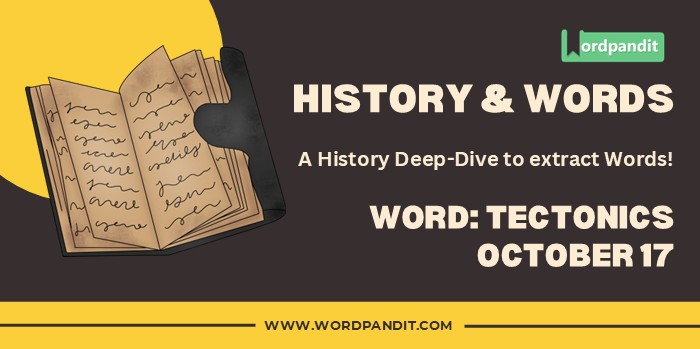History & Words: 'Tectonics' (October 17)
Welcome to 'History & Words.' 🌟 I'm Prashant, founder of Wordpandit and the Learning Inc. Network. This series combines my passion for language learning with historical context. Each entry explores a word's significance on a specific date, enhancing vocabulary while deepening understanding of history. Join me in this journey of words through time.
📚 Table of Contents
- Word of the Day
- Introduction
- Etymology
- Key Vocabulary
- Historical Context
- Timeline
- The Day's Significance
- Quote
- Modern Usage and Reflection
- Legacy
- Comparative Analysis
- Did You Know?
- Conclusion
- Further Reading
🔍 Word of the Day: Tectonics
Pronunciation: /tɛkˈtɒnɪks/ (tek-TON-iks)
🌍 Introduction
On October 17, 1989, at 5:04 PM local time, the San Francisco Bay Area was rocked by a powerful earthquake that would come to be known as the Loma Prieta earthquake. This seismic event, measuring 6.9 on the Richter scale, lasted for approximately 15 seconds but left an indelible mark on the region's history and collective memory. The earthquake caused significant damage to infrastructure, resulted in 63 fatalities, and injured thousands more.
The Loma Prieta earthquake thrust the concept of "tectonics" into the public consciousness, highlighting the dynamic and often destructive forces that shape our planet. This event served as a stark reminder of the power of plate tectonics and the importance of understanding these geological processes for public safety and urban planning.
🌱 Etymology
The word "tectonics" comes from the Greek "tektonikos," meaning "pertaining to building." It is derived from "tekton," which means "builder" or "carpenter." In its original context, it referred to the art of construction or building. Over time, geologists adopted the term to describe the large-scale processes that shape the Earth's crust, likening these forces to a grand architect building and reshaping the planet's surface.
The concept of plate tectonics, which explains how the Earth's lithosphere is divided into several plates that move relative to one another, was not fully developed until the 1960s. However, the Loma Prieta earthquake in 1989 brought this scientific theory into sharp focus for the general public.
📖 Key Vocabulary
- 🔑 Fault line: A fracture or zone of fractures between two blocks of rock in the Earth's crust.
- 🔑 Seismology: The scientific study of earthquakes and the propagation of seismic waves through the Earth.
- 🔑 Liquefaction: A phenomenon where saturated soil loses strength and stiffness in response to applied stress, such as shaking during an earthquake.
- 🔑 Retrofitting: The addition of new technology or features to older systems, particularly in this context, reinforcing buildings to better withstand earthquakes.
- 🔑 Subduction zone: An area where two tectonic plates meet and one slides beneath the other.
🏛️ Historical Context
The Loma Prieta earthquake occurred in a region well-known for its seismic activity. The San Francisco Bay Area sits astride the boundary between two major tectonic plates: the Pacific Plate and the North American Plate. This boundary is marked by the infamous San Andreas Fault system, a complex network of faults that has been the source of numerous earthquakes throughout history.
The earthquake of 1989 was not the first major seismic event to strike the region. The devastating 1906 San Francisco earthquake, which nearly destroyed the city, had occurred along the same fault system. In the intervening years, significant advancements had been made in understanding plate tectonics and earthquake mechanics, but the Loma Prieta quake demonstrated that much work remained to be done in terms of preparedness and infrastructure resilience.
The late 1980s was a period of rapid technological advancement and urban growth in the San Francisco Bay Area, particularly with the rise of Silicon Valley. This earthquake served as a sobering reminder of the need to balance development with respect for the region's geological realities.

⏳ Timeline
- April 18, 1906: Great San Francisco Earthquake (magnitude 7.9)
- 1960s: Development of the theory of plate tectonics
- October 17, 1989, 5:04 PM: Loma Prieta earthquake strikes
- October 17, 1989, 5:27 PM: Game 3 of the World Series postponed
- October 18, 1989: President George H.W. Bush declares a major disaster
- October 21, 1989: Bay Bridge reopens for traffic
- November 18, 1989: I-880 Cypress Street Viaduct demolished
- 1989-1990: Significant seismic retrofitting begins in the Bay Area
- 2013: New eastern span of the Bay Bridge opens, designed to withstand major earthquakes
🌟 The Day's Significance
October 17, 1989, stands as a pivotal moment in the understanding and public awareness of tectonics and seismic risk. The Loma Prieta earthquake, striking just before the start of the third game of the World Series between the San Francisco Giants and the Oakland Athletics, captured national attention and brought the reality of earthquake danger to the forefront of public consciousness.
The significance of this day lies not just in the immediate impact of the earthquake, but in how it reshaped approaches to urban planning, building design, and disaster preparedness in seismically active regions. The collapse of the Cypress Street Viaduct in Oakland and the partial collapse of a section of the Bay Bridge highlighted vulnerabilities in critical infrastructure, leading to major retrofitting projects and changes in construction standards.
Moreover, the earthquake underscored the importance of ongoing research in tectonics and seismology. It provided valuable data for scientists studying the behavior of faults and the propagation of seismic waves, contributing to improved earthquake prediction and risk assessment models.
The event also demonstrated the complex interplay between geological forces and human society. The fact that the earthquake occurred during rush hour and just before a major sporting event influenced its impact and the public's perception of seismic risk.
📜 Quote
"Earthquakes don't kill people, buildings do." - Dr. Lucy Jones, seismologist and public voice for earthquake science and preparedness
This quote, while not directly about the Loma Prieta earthquake, encapsulates a key lesson learned from events like it, emphasizing the importance of building design and urban planning in mitigating earthquake damage.
🔎 Modern Usage and Reflection
Today, the study of tectonics continues to be crucial in understanding and preparing for seismic events. Advanced technologies like GPS and satellite imaging allow for more precise measurements of plate movements, contributing to better earthquake forecasting and risk assessment.
The lessons learned from the Loma Prieta earthquake have informed building codes and urban planning not just in California, but in seismically active regions worldwide. The concept of "earthquake-resistant design" has become standard in architecture and engineering, reflecting a growing awareness of the need to work with, rather than against, tectonic forces.
📜 Legacy
The Loma Prieta earthquake left a lasting legacy on the San Francisco Bay Area and beyond. It led to significant improvements in seismic safety standards, including the retrofitting of many bridges, buildings, and highways. The event also spurred increased funding for earthquake research and preparedness programs.
In the realm of public policy, the earthquake highlighted the importance of community preparedness and effective emergency response systems. It led to the development of better early warning systems and public education programs about earthquake safety.
The scientific understanding gained from studying the Loma Prieta earthquake has contributed to advancements in seismology and our understanding of fault mechanics. This knowledge has been applied to improve earthquake risk assessments in other seismically active regions around the world.
🔄 Comparative Analysis
While the Loma Prieta earthquake was significant, it can be compared to other major seismic events to understand its place in the broader context of tectonic activity. For instance, the 1906 San Francisco earthquake was more powerful and destructive, while the 1994 Northridge earthquake in Los Angeles, though less powerful, caused more economic damage due to its location in a densely populated area.
Internationally, events like the 2011 Tohoku earthquake in Japan have demonstrated the potential for even more catastrophic outcomes, particularly when earthquakes trigger secondary disasters like tsunamis.
❓ Did You Know?
The Loma Prieta earthquake occurred on the 63rd anniversary of the 1926 World Series, in which the Yankees swept the Cardinals. This coincidence, along with the fact that the 1989 World Series was in progress, led some to dub it the "World Series Earthquake."
📝 Conclusion
The Loma Prieta earthquake of October 17, 1989, stands as a powerful reminder of the tectonic forces that shape our planet and the need for human societies to understand and adapt to these forces. As we reflect on this event, we are reminded of the ongoing challenges posed by seismic activity in many parts of the world and the importance of continued research, preparedness, and resilient infrastructure design. The story of the Loma Prieta earthquake and its aftermath demonstrates both the destructive power of tectonic forces and human capacity for resilience and adaptation in the face of natural disasters.
📚 Further Reading
- 📖 "The Great Quake: 1906-2006" by David Perlman
- 📖 "Earthquake Nation: The Cultural Politics of Japanese Seismicity, 1868-1930" by Gregory Clancey
- 📖 "Living with Earthquakes in California: A Survivor's Guide" by Robert S. Yeats












